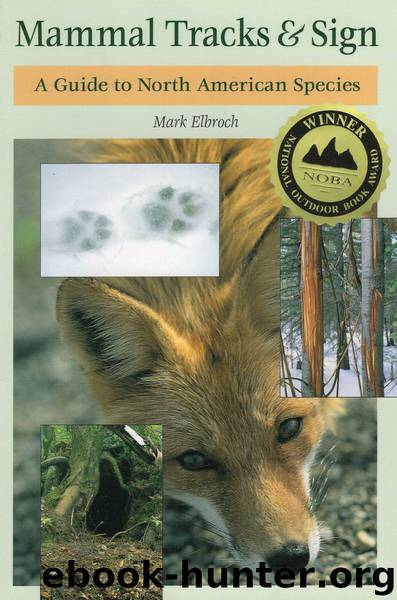Mammal Tracks & Sign by Mark Elbroch

Author:Mark Elbroch
Language: eng
Format: epub
ISBN: 9780811743334
Publisher: Stackpole Books
Muskrat. Muskrats form runs between water sources and leading from burrow systems (in habitats where they do not build lodges) to feeding areas. You can also find them connecting ponds to each other over quite large distances, as well as connecting ponds to feeding areas on land. The walls of muskrat runs are usually vertical, like those of other rodents, and they have square edges. Widths range from 3½ to 5½ inches(8.9 to 14 cm).
Snowshoe hare. Snowshoe hare runs are more like cottontail than jackrabbit runs, in that they have softer and rounder edges. Widths range from 4 to 8 inches (10.2 to20.3 cm).
Jackrabbit. Jackrabbits form runs in a variety of substrates, most easily discernible in snow. Although all species form runs, black-tailed jackrabbit runs are particularly impressive. In southern Idaho, in about 16 inches of snow, the walls of these runs were 10 inches high. Of all the rabbits, the black-tailed jackrabbit makes runs with the most vertical and crisp walls and edges. Widths range from 5 to 9 inches(12.7 to 22.9 cm).
Porcupine. Porcupine runs lead directly from trees, rock ledges, or other cover to feeding areas—often a grove of mast-producing trees or conifers in the winter. Runs are alsofound following wetland edges. Scat and quills should be evident along the runs. The walls of porcupine runs are not as crisp as those of smaller rodents. Widths range from 6 to 9 inches (15.2 to 22.9 cm).
Download
This site does not store any files on its server. We only index and link to content provided by other sites. Please contact the content providers to delete copyright contents if any and email us, we'll remove relevant links or contents immediately.
Sapiens: A Brief History of Humankind by Yuval Noah Harari(13128)
The Tidewater Tales by John Barth(12047)
Do No Harm Stories of Life, Death and Brain Surgery by Henry Marsh(6351)
Mastermind: How to Think Like Sherlock Holmes by Maria Konnikova(6278)
The Thirst by Nesbo Jo(5821)
Why We Sleep: Unlocking the Power of Sleep and Dreams by Matthew Walker(5681)
Sapiens by Yuval Noah Harari(4582)
Life 3.0: Being Human in the Age of Artificial Intelligence by Tegmark Max(4544)
The Longevity Diet by Valter Longo(4468)
The Rules Do Not Apply by Ariel Levy(3939)
The Body: A Guide for Occupants by Bill Bryson(3863)
The Immortal Life of Henrietta Lacks by Rebecca Skloot(3844)
Why We Sleep by Matthew Walker(3800)
Animal Frequency by Melissa Alvarez(3772)
Yoga Anatomy by Kaminoff Leslie(3726)
Barron's AP Biology by Goldberg M.S. Deborah T(3646)
The Hacking of the American Mind by Robert H. Lustig(3602)
All Creatures Great and Small by James Herriot(3543)
Yoga Anatomy by Leslie Kaminoff & Amy Matthews(3421)
